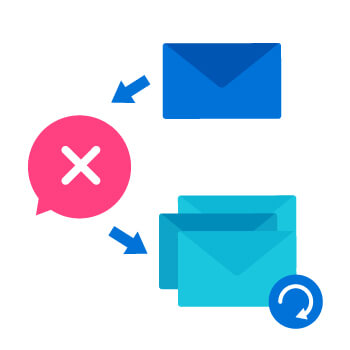How to Get Past the Gatekeeper (With Templates)

Contents
Cold emails are an awesome tool for generating new leads and building relationships. The ability to target your message and refine it over time opens the door to high-quality leads. However, there’s usually someone standing in that doorway – a gatekeeper.
Whether they’re an executive assistant or a regional manager, they’re tasked with guarding the door – and without the right messaging and strategy, you might have that door closed on you before you’ve had your chance to shine.
Here’s what you need to know to get past the gatekeeper and reach your target.
Prepare Your Message
When your first contact is through email, every word counts. Have an eye-catching subject line that is personalized, short, and catchy. Use the snippet underneath your subject line to spark interest and communicate a benefit.
Also – there’s no point in being brief if you don’t make the email easy to respond to.
Which is less of a hassle: “Please let me know your availability,” or “Would you be free on Wednesday at 2 or 4 p.m.?” The latter clearly makes it as easy as possible for them to say yes.
If you’re planning to send out many cold emails (which you should), split-test your messaging and track which emails get opened the most. Always work to tweak and improve your messages based on the results of your testing.
A well-crafted email that looks informative, relevant, and compelling is more likely to be passed on by the gatekeeper.
Before You Reach the Gate, Ring the Bell
Do what you can to engage with your target lead before reaching out with a cold email. For example, try connecting with them on LinkedIn. The best practices for sending a great LinkedIn message are a little different, but the main principles still apply. Stick to the three S’s: short, simple, and (throw in some) social proof.
If you can, send a simple message like, “Hey there! I’ve been looking for industry partners to connect with and saw your profile. Would love to connect.”
If they accept your request, see if you can have them agree to receive additional info via LinkedIn. Or, you can try your luck and send them a cold email directly.
Try an email verification service like Voila Norbert to use the information that you do have to source their email address.
This tip is an attempt to get around the gatekeeper entirely. It doesn’t always work, but it at least gets your target familiar with your name.
If the gatekeeper does pass on your name, it might ring a bell with your target.
Boost Your Credibility by Name-Dropping
Whose email would you rather forward? “Please forward this email to your manager,” or “It’d be great if you could help me set a time to talk to Joe or Cindy.”
A gatekeeper is more likely to put you in touch if you can establish a connection or previous rapport with your target lead. Something as simple as dropping their name, a shared university, or common interest might be enough.
This is also why connecting on LinkedIn is so helpful. It gets you on a first-name basis with your target lead and makes getting past the gatekeeper a little easier.
Now you can technically say that you’re following up from a previous conversation – even if that was just a ‘hello’ on LinkedIn.
Don’t forget to leverage your network. Do some digging and see how close you can get to your lead through mutual friends, family, or colleagues. Let them know who you’re looking to reach and ask if they’d be willing to put you in touch.
And it goes both ways – if you know someone that your target would benefit from knowing, get in touch and try to offer an introduction. Either way, a warm email is infinitely better than a cold one.
No gatekeeper wants to be the one that didn’t connect their boss with a trusted friend or colleague.
Ask for More Information on Something They Engaged With
Whenever you’re trying to build rapport, the best place to start is by following your lead on social media.
Look for opportunities to interact and engage with them. Comments on news articles, their own blog posts, and retweets are all great ways to build rapport.
Once you see something relevant, leave a comment or email them and ask for more information. Gatekeepers may be more likely to let you through if you appear to be asking for insight or expertise. Most people are willing to help someone asking a simple question.
Regardless of whether or not you get a response, engaging with relevant content is a great way to establish yourself as someone who keeps tabs on the latest happenings.
Ask for Their Expert Opinion
Similar to the suggestion above, invite the lead to share their voice on a platform of your own. Maybe they have a press release they’d like distributed, or they can guest post on your blog or provide a quote for an article you’re writing.
If there was a recent news or industry event that occurred, try asking the gatekeeper to put you in touch with their boss so you can ask for their expert opinion.
This method works wonders, because, although your request is a one-time thing, it opens the door for further conversations. Having a clear start and end to your request may entice the gatekeeper to let you through.
These are all friendly and natural ways to start a conversation with the gatekeeper or your target.
Work With the Gatekeeper
Now, hear me out. Sometimes the best way isn’t out, but through.
Instead of treating the gatekeeper like a roadblock, think about how they can help you in the long run.
Gatekeepers often have their ear to the ground and have detailed knowledge of a range of company projects. See if there’s a way you can get this information and leverage it to make a more compelling offer.
For example, maybe you can set up the first appointment with them instead of someone higher up. You could also try setting up a no-commitment call to learn more about current company challenges and goals.
If nothing else, having this valuable information will make your next pitch even stronger.
Be Persistent
Sometimes, it’s genuinely just not a good time when you call. But that’s no excuse not to stay in touch.
The Society for Marketing Professional Services estimates that 43% of salespeople give up after the first contact. After the second contact, a whopping 68% of salespeople give up. That means that if you make contact a third time, you’re ahead of nearly 70% of your competition.
Roughly 80% of prospects say ‘no’ four times before they ultimately say ‘yes’. Following up should be a key part of your strategy.
First, keep your email short, sweet, and conversational. Make it clear that you strongly believe in your product or service’s ability to solve a specific problem for them.
In additional follow-up emails, offer some information that they’d be likely to share with their colleagues. This could be anything from a reference checklist to an industry events calendar.
Use a service like Right Inbox to customize and prepare your response emails ahead of time. For example, you can craft your no-response message in advance. If they do respond, the automatic message will be cancelled, and you’ll be notified to write a new response. It makes keeping up with your potential leads easy and personalized.
Gatekeeper Cold Email Template
Try out this cold email template for your next pitch to a gatekeeper.
Conclusion
At the end of the day, gatekeepers aren’t trying to give you a hard time. They are fellow professionals and you should see them as stakeholders in the sale.
By building a positive rapport with the gatekeeper, you may even create an internal champion for your product or service.






